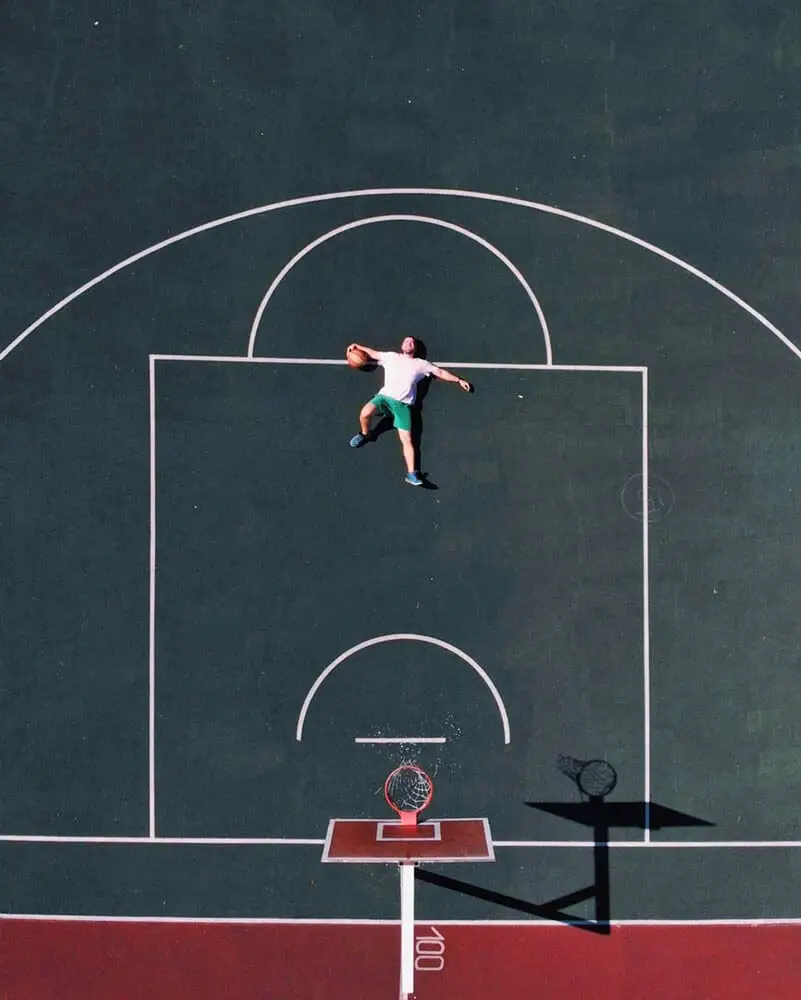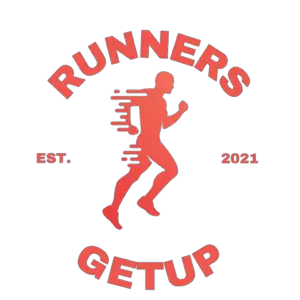This post contains affiliate links.
I was asked by a friend to play for their basketball team, but I didn’t have a pair of basketball shoes and I certainly don’t want to spend on one. So I wore my old pair of running shoes for the whole duration of the league including our practices and here’s what I observed:
Yes, you can wear running shoes to play light basketball. However, using it in-game is not recommended. It lacks ankle support and overall stability that may result in injuries. Plus, it’s not durable enough to handle intense multidirectional movements.
Ahead, we will look at the differences between the two types of shoes and look at how running shoes perform in certain aspects of basketball.
Running Shoes Vs Basketball Shoes: What’s the Difference?
Running shoes and basketball shoes are built so differently from each other that there is absolutely no way of mistaking one from the other.
At a quick glance, you’ll see that running shoes have a low cut, narrow, and somewhat curved platform. Basketball shoes, on the other hand, have a higher cut (past the ankle), a bulkier upper, and have a wider and flatter platform.
That’s because both shoes are designed for completely different purposes.
Running shoes are built for absorbing shock for long periods in a linear direction (forward).
Basketball shoes are designed to provide foot and ankle stability for sudden stops and changes in direction, jumping, turning, and lateral movements.
Let’s go a little bit deeper into the differences between the two on multiple aspects.
Upper
Running shoes use a light upper (usually mesh) that focuses on lightness and the breathability of the shoe. In other words, running shoe uppers are designed to help cool your feet and not add unnecessary weight.
Basketball shoes, on the other hand, have thicker, heavier, and more durable uppers made out of a combination of mesh and leather.
Unlike running shoes, it’s designed for durability and overall lockdown which is needed for the multidirectional movements of basketball.
Midsole
Running shoes have a high stack height and softer midsole compared to basketball shoes. Most running shoes also have a higher heel-to-toe drop that tips the runner forward on the run.
This high stack height contributes well to shock absorption and joint protection, particularly in long runs. However, this also means that the wearer has a higher center of gravity and is more prone to rolling an ankle.
Basketball shoes have a lower stack height and heel-toe drop to help provide a more stable platform and reduce the occurrence of rolling an ankle.
Outsole
There’s a lot of different kinds of outsoles for running shoes, but let’s talk about the outsole of a regular road running shoe.
Road running shoes are designed to be run on rough pavement and very light trails. They have thicker outsoles with slightly deep lugs.
Basketball shoes are designed for very smooth surfaces – the kind that squeaks. This is why they are designed flat and with grooves to provide more friction on smooth surfaces.
Stability
Running shoes have a narrower and slightly curved platform designed to aid with the transition during the gait cycle. It promotes speed and efficiency but less lateral stability.
Basketball shoes are wider and flat making them stable on the ground and able to move side to side as well as perform sudden changes in direction.
Support
The support needed for running is different from the support needed in basketball.
The support needed for running is simply for the prevention of overpronation, hence the stability shoes.
Basketball shoes require ankle support as well as improved overall shoe lockdown to prevent the foot from sliding inside the shoe.
This is why basketball shoes have a higher cut to provide ankle support and lots of hard materials that extend in the upper to keep your foot locked in place.
Responsiveness
Generally speaking, flat, firmer, and lesser midsoles result in better responsiveness. And despite running shoes being labeled as responsive, basketball shoes are generally more responsive than running shoes.
Cushioning
Cushioning is important in both running and basketball, but the way they provide it differs from one another.
The entire midsole of a running shoe from the heel to the forefoot is usually soft to help absorb shock for repetitive but small impact.
Basketball shoes have strategically placed cushioning to soften landings and generate power at the same time.
In other words, running shoes focus on comfort while basketball shoes focus on springiness.
Breathability
Running shoes are designed with a light, mesh upper which makes them very breathable. Basketball shoes, on the other hand, need a thicker upper to provide structure and protection. It also makes the shoes’ upper more resistant to the shear force that happens when there are rapid and sudden changes in direction.
Weight
Even the lightest basketball shoes don’t even compare to the lightness of running shoes.
Running shoes minimize the use of unnecessary materials to keep the shoe light. While basketball shoes need those extra materials to provide support.
The average weight of a running shoe is only 9.5 ounces, while basketball shoes are around 15 ounces.
Durability
Running shoes are made of light materials which also means they are more likely to get damaged easier.
Basketball shoes, on the other hand, are built like tanks. They have a thicker upper, firmer structure, and better stitches to handle multidirectional shear and the intensity of the game.
Running Shoe Performance in Basketball
Now that we’ve looked at the differences in both types of shoes, let’s look at how running shoes fair in court.
Rebounding
Due to the lightness and soft cushioning of running shoes, I find them good for rebounding vertically (that’s when you’re standing beneath the ring and just jump up and down without an angle). It feels like the drop of weight makes me jump higher and the extra cushion lessens the impact on my joints.
However, I find it relatively easy to twist an ankle when you rebound at an angle. This is due to its high stack height and lack of support.
In addition, your foot tends to slide inside the shoe if you make a forward jump. Don’t get me wrong, running shoes have a good lockdown. But they’re nothing compared to the lockdown of basketball shoes.
Overall I’ll give running shoes a 7.5/10 in rebounding.
Ball Handling
By ball handling, I mean Steph Curry or Kyrie Irving ball handling which involves a lot of shifting, jolts, and shifts in direction.
Running shoes can’t handle intense ball handling. It feels very unstable and too cushioned for quick jolts and acceleration.
Overall score: 6/10
Defense
Again, running shoes don’t fare well during lockdown defense in an intense ball handler.
Defense is dominantly lateral motion which requires tons of ankle support and stability that running shoes don’t have.
I’ll give running shoes an overall score of 5/10 for defense.
Attacking the Basket
I usually attack the basket when I have a clean run to it. So running shoes work fine for my style.
Even at times where I’m met with a defender and have to do a crossover or a Euro step, I can do it in a running shoe with no problem.
Overall score: 8/10
Quick changes in direction
Basketball requires sudden changes of motion that don’t fit the characteristics of a running shoe that is built to move forward.
If you’re a quick basketball player who moves side to side a lot and trying to find open spots, then there’s absolutely no way that you’re going to enjoy wearing a running shoe to a basketball game.
Overall score: 4/10
Chase Down/Running
This is probably the only aspect that running shoes do better than basketball shoes – chase down.
No doubt, running shoes make you a faster runner and you will have a slight advantage in chasing down opponents.
Overall score: 10/10
Overall Score
Upon testing running shoes in-game, I found that the biggest problem running shoes have is support and stability.
Sure, there are what we call stability running shoes, however, they do not come close to the support and stability that is required for the sport basketball.
| Activity | Score | Observation |
|---|---|---|
| Rebounding | 7.5/10 | Good at vertical but not good in rebounding at an angle. |
| Ball handling | 6/10 | Not good for intense changing of directions and jolting. |
| Defense | 5/10 | Too unstable for making lateral movements. |
| Attacking the basket | 8/10 | Decent in attacking forward. |
| Quick changes in direction | 4/10 | Too unstable. You might roll an ankle. |
| Chase down/running | 10/10 | You feel a lot faster |
| Total score | 6.75/10 | You can use it but not in-game. |
The Cons of Wearing Running Shoes For Basketball
- You’ll damage your running shoes easily
- It’s less responsive
- Harder to move side to side
- It’s harder to create an opening because it’s hard to do jolts and fakes.
- Harder to do lockdown defense.
- It’s too unstable making it more likely to cause injuries
Are Running Shoes Good For Basketball?

The short answer is NO, running shoes are not good alternatives to basketball shoes. They’re too high and unstable for a sport that requires sudden jolts and lateral movement.
However, there’s no problem wearing them to shoot around, play H.O.R.S.E, or anything like that. One that requires less intensity on lateral movements.
Final Thoughts
Athletic shoes are made with different names for a reason. They serve a different purpose that caters to the activity that each sport requires. And although you can use one to do the activity of the other, it will not allow you to perform at your best.
With that, I suggest you grab a pair of basketball shoes if you’re likely to play in-game.
